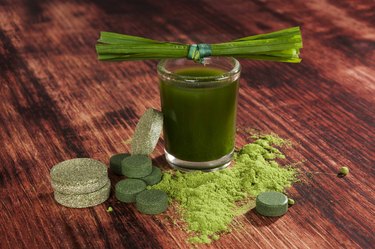
Wheatgrass and barley grass are usually dried and sold in powder or tablet form because the sprouts are hard to digest. As a general guideline, tablets contain fewer nutrients than powders per dose, and wheatgrass supplies more vitamins and minerals than barley grass. Both provide chlorophyll and vitamins A, C and K, however. If you take anticoagulant medication, talk to your doctor before consuming either supplement.
Nutrient Content
Video of the Day
Even though barley grass and wheatgrass naturally contain a range of vitamins and minerals, commercially prepared powders have inconsistent amounts of nutrients. You'll need to compare labels because the difference between brands is significant.
Video of the Day
For example, one brand of wheatgrass powder has about 100 percent of the daily value for vitamin K and 23 percent of vitamin C, while another brand has double the vitamin K and four times more vitamin C. Similar differences exist between brands of barley grass powders. One brand has 75 percent of the daily of vitamin K and 10 percent of vitamin A, and a second brand has about half the vitamin K and double the vitamin A.
Expect the barley grass and wheatgrass you buy to provide at least 15 percent of the daily value -- and preferably more -- for vitamins A, C and K.
Sources of Chlorophyll
Wheatgrass powder generally contains more chlorophyll than barley grass powder. Two brands of wheatgrass powder have 32 milligrams and 42 milligrams of chlorophyll, while a brand of barley grass powder has about 13 milligrams. When you buy supplements, just be sure to choose brand that actually lists the amount of chlorophyll per dose on the label.
Chlorophyll has the ability to bind with substances that may cause cancer, such as damaging molecules in tobacco smoke. As it binds with cancer-causing chemicals, chlorophyll reduces the amount of carcinogens that get to tissues in your body, reports the Linus Pauling Institute.
Multiple Antioxidants
In addition to antioxidant vitamin C, barley grass and wheat grass contain other plant-based antioxidants. Both grasses are sources of superoxide dismutase, which is one of the body's most powerful and important antioxidants, reports Life Extension.
Barley grass contains a flavonoid called saponarin, an antioxidant that helps block free radical damage in essential fats such as omega-3 fatty acids, according to the Journal of Agricultural and Food Chemistry in 2012.
Wheatgrass has a long list of phytochemicals, including antioxidant flavonoids and saponins. Saponins show potential to lower cholesterol, while flavonoids fight inflammation and may help prevent cancer. Wheatgrass and barley grass must be studied to see if they deliver these benefits to people, however.
Potential Side Effects
Barley grass and wheatgrass are both high in vitamin K, which can interfere with medications used to prevent blood clots, such as warfarin. Check with your doctor before using either supplement because the medication's dose may need to be adjusted.
People who are allergic to wheat should avoid wheatgrass. Even though barley grass and wheatgrass are considered gluten-free, their seeds contain gluten, which means there's a risk of cross contamination. To be safe, don't consume either grass if you have celiac disease.
In rare cases, consuming a high amount of chlorophyll from either source could cause diarrhea and stomach cramps.
- Linus Pauling Institute: Chlorophyll and Chlorophyllin
- Drugs.com: Barley Grass
- Life Extension Magazine: Superoxide Dismutase Boosting the Body’s Primary Antioxidant Defense
- Journal of Agricultural and Food Chemistry: Flavonoids With Potent Antioxidant Activity Found in Young Green Barley Leaves
- Asian Pacific Journal of Tropical Medicine: Phytochemical Screening and Analysis of Antioxidant Properties of Aqueous Extract of Wheatgrass
- Phytochemicals: What Is Saponin
- Food Allergy Research and Education: Wheat
- Celiac Disease Foundation: What Can I Eat?
- MedlinePlus: Chlorophyll
- Office of Dietary Supplements: Vitamin K
- Green Foods: Wheat Grass Shots
- Amazing Grass: Organic Wheat Grass
- Pure Synergy Organics: Barley Grass Juice Powder
- Green Foods: Green Magma Barley Grass Juice